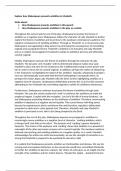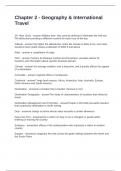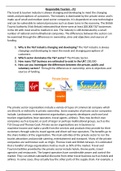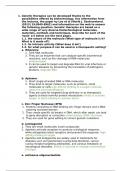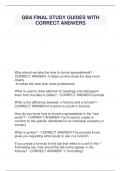Corporate Financial Management
Inhoud
Week 1:..............................................................................................................................................2
Week 2:..............................................................................................................................................4
Week 3:..............................................................................................................................................7
Week 4:............................................................................................................................................12
Week 5:............................................................................................................................................17
Week 6:............................................................................................................................................20
1
,Week 1:
• A set of cash flows that has a positive NPV adds value to your company, a negative value implies a
loss of value.
• Discount rates are closely tied to risk: the riskier the cash-flow, the more expected return is
required to make investors / companies take on the risk.
• As Chapter 5 indicates, there may be different discounts rates for different time periods: the
interest rate for a loan starting now and maturing (i.e., due for repayment) in 30 days is different
from that for a loan maturing in 10 years. Again, this is due to differences in risk and time value of
money.
Arbitrage
• If we value a good at $40, while the market values it as $50, we shouldn’t be using it, but selling it
for 50. We’re leaving a $10 profit on the table (or forgetting to take $10 of costs into account…)
• Likewise, if our valuation is above the market’s, you should buy the good in the market.
• Making money out of price differences for the same good is called arbitrage. It’s a riskless profit.
Financial markets are quite efficient at setting prices such that there is no arbitrage – so prices are
the same. The market price is the only (relevant) price.
Market values vs. book values
• Yet market prices / values aren’t always the same as book values.
The principles behind them differ:
– book values reflect what is present right now, as an accumulation of past actions.
– Market values reflect what is expected in the future: they derive their value based on what future
user are willing to pay. Expectations feature heavily in these values, so they mainly depend not on
the past, but on future potential
• If you have an Effective Annual Rate (EAR), that is what you will truly receive (or pay). An EAR of
5%, which periods lasting 6 months, is in fact 2,47% per period, so that (1.0247)2 = 1.05.
• If you have an APR (Annual Percentage Rate) it’s a simple interest rate, which disregards
compounding. Paying an APR of 18%, with monthly compounding is actually even more expensive.
18/12 =1.5% a month. 1.01512 = 1.196, so the EAR is 19.6%!
2
, 3
Inhoud
Week 1:..............................................................................................................................................2
Week 2:..............................................................................................................................................4
Week 3:..............................................................................................................................................7
Week 4:............................................................................................................................................12
Week 5:............................................................................................................................................17
Week 6:............................................................................................................................................20
1
,Week 1:
• A set of cash flows that has a positive NPV adds value to your company, a negative value implies a
loss of value.
• Discount rates are closely tied to risk: the riskier the cash-flow, the more expected return is
required to make investors / companies take on the risk.
• As Chapter 5 indicates, there may be different discounts rates for different time periods: the
interest rate for a loan starting now and maturing (i.e., due for repayment) in 30 days is different
from that for a loan maturing in 10 years. Again, this is due to differences in risk and time value of
money.
Arbitrage
• If we value a good at $40, while the market values it as $50, we shouldn’t be using it, but selling it
for 50. We’re leaving a $10 profit on the table (or forgetting to take $10 of costs into account…)
• Likewise, if our valuation is above the market’s, you should buy the good in the market.
• Making money out of price differences for the same good is called arbitrage. It’s a riskless profit.
Financial markets are quite efficient at setting prices such that there is no arbitrage – so prices are
the same. The market price is the only (relevant) price.
Market values vs. book values
• Yet market prices / values aren’t always the same as book values.
The principles behind them differ:
– book values reflect what is present right now, as an accumulation of past actions.
– Market values reflect what is expected in the future: they derive their value based on what future
user are willing to pay. Expectations feature heavily in these values, so they mainly depend not on
the past, but on future potential
• If you have an Effective Annual Rate (EAR), that is what you will truly receive (or pay). An EAR of
5%, which periods lasting 6 months, is in fact 2,47% per period, so that (1.0247)2 = 1.05.
• If you have an APR (Annual Percentage Rate) it’s a simple interest rate, which disregards
compounding. Paying an APR of 18%, with monthly compounding is actually even more expensive.
18/12 =1.5% a month. 1.01512 = 1.196, so the EAR is 19.6%!
2
, 3


